
An exhibit program called "Light: Beyond the Bulb" (or LBTB) has been developed to help engage non-expert audiences with the capabilities of light, due, in part, to the opportunity provided by International Year of Light and Light-based Technologies (IYL 2015). This global initiative was adopted by the United Nations for 2015, supported by UNESCO, the International Astronomical Union, and a host of other scientific societies, organizations, corporations and individuals around the world.
"Light: Beyond the Bulb" (http://lightexhibit.org) is a free, open-access international exhibition program containing 75 images that were crowd-sourced from photographers, scientists, and artists, and expert-curated for science content, high-quality printability, aesthetics, and potential to be relevant and interesting for non-experts. In collaboration with experts in the field, the project creators developed short, descriptive captions designed to focus on various aspects of light and its properties, from refraction and reflection to transits and shadows. The scale of the materials travel from the insides of a cell, all the way out across the other side of the Universe. "Light: Beyond the Bulb" showcases materials in a range of topics, from microbiology to astronomy, and creates connections with physics, optics, photonics, atmospheric and earth sciences, astrophysics, and more.
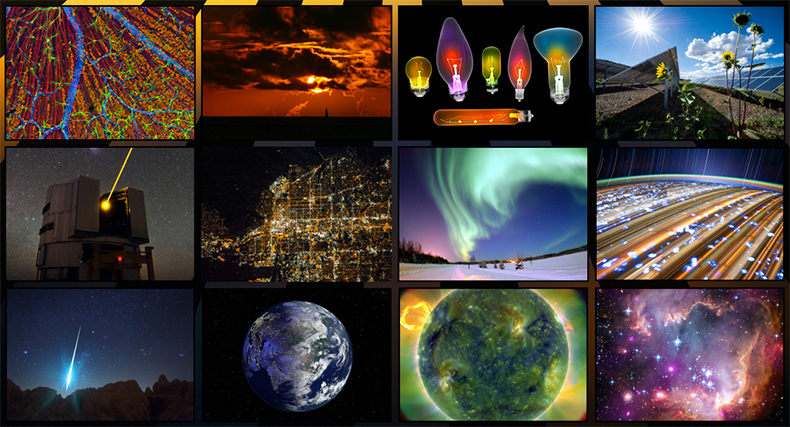
A selection of images from the Light: Beyond the Bulb project, from a mouse retina, to light pollution, to star formation.
Credit: LBTB
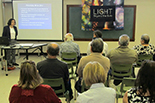 |
|
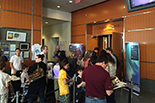 |
|
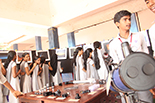 |
There are over 600 sites in progress or being planned for 2015-2016, in over 30 countries, with over a dozen language translations. Examples of locations include exhibits at the O’Hare Airport in Chicago, U.S., the Village Baykal in Dolna Mitropolia, Bulgaria, the St. Ignatius College Siggiewi Primary School in Siggiewi, Malta, the K11 Art Mall in Shanghai, China, and the Galway Astronomy Festival in Ireland. Hundreds of the sites are also occurring in U.S. schools, science centers, libraries, parks and other informal learning spaces through small exhibits of Light: Beyond the Bulb posters as provided by SPIE and the Chandra X-ray Center. (Full exhibit list: http://lightexhibit.org/iylexhibits.html)
| France | United States | Mauritius | Venezuela | Argentina |
| United Kingdom | Brazil | Serbia | South Africa | Puerto Rico |
| Spain | Canada | Columbia | Austria | India; |
| Mexico | Russia | Australia | Ireland | New Zealand |
| Malta | China | Bulgaria | Azerbaijan | Malayzia |
| Switzerlans | Poland | Uruguay | Portugal | Costa Rica |
| Germany | Scotland | Italy | Norway | Montenegro |
| Paraguay |
TOP LEFT: For the month of April in 2015 a Chandra-funded exhibit of "Light: Beyond the Bulb" was displayed at the main library of the University of Puerto Rico (UPR) and impacted thousands of persons, according to event coordinators. Exhibit tours with hands-on activities on the topics of lensing, shadows, electric discharge, atomic collisions and others were conducted by volunteer physics students. Additional talks, conferences, and other events connected to the exhibit attracted many hundreds of participants. Groups of local school children & their teachers visited from neighboring towns. University students attended with professors from courses in Physics, Architecture, Art and Education.
Credit: UPR
Middle Left: At Duke University (Durham, North Carolina, U.S.) the Fitzpatrick Institute for Photonics Annual Symposium hosted the World Photonics Forum with international speakers as well as an Open House for the greater public. One goal of the event was to help bring together experts and non-experts to discover new ideas about light and light technologies in celebration of IYL2015. Held during the week of March 8, 2015, about 700 people attended with approximately 500 members representing the public and 200 representing symposium attendees and speakers.
Credit: Duke University.
Bottom Left: In February 2015, an amateur astronomer organization created a special event for the Palora Higher Secondary School (Palora,Ulliyeri, Kozhikode, India). The exhibition was conducted alongside an inauguration event for a new telescope. Approximately 2,500 attendees participated in the exhibition program to celebrate the International Year of Light 2015. Physics department head MR Sreekumar of Devagiri college Kozhikode delivered a lecture on light pollution—one of the key topics of IYL2015- and the its effects on nocturnal life.
Credit: Chindankutty Nambiar, Astronomical Organisation Kerala (AASTROKERALA)
Networks of science hosts created by previous projects spearheaded by the Chandra X-ray Observatory Center including "From Earth to the Universe," "From Earth to the Solar System," and "Here, There & Everywhere" were combined with networks from SPIE, the international society for optics and photonics, as well as the International Astronomical Union and others to announce the project, garner program interest, and help promote the events. This aspect of tapping into networks of volunpeers, as shown to be critical in evaluation and survey data from previous projects was an important component of launching a new project in a relatively short time period (approximately over the course of a year). There was existing buy-in for such community-based, grassroots projects for a number of hosts as well as "proof of concept" for new hosts.
"Light: Beyond the Bulb" has allowed both a re-energization of existing networks developed over years of astronomy communicate including IYA 2009, and has provided the opportunity to reach out to new partners and delve into topics that are often well beyond the scope of astronomy. Using light to thread these seemingly disparate scientific topics together allows for a more coherent scientific story to be told for the scientific disciplines involved.
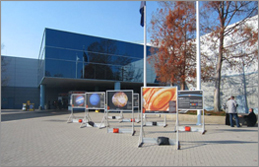 |
 |
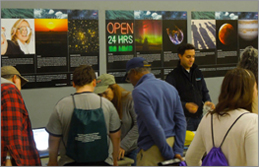 |



